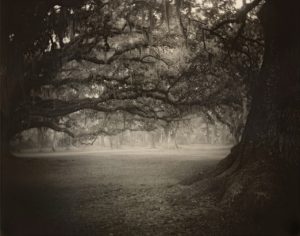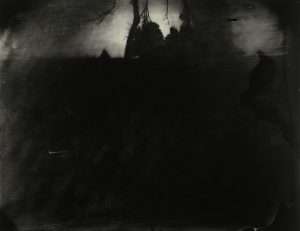A slight, and at first puzzling, sense of disappointment came over me as I exited A Thousand Crossings, the otherwise totally engrossing Sally Mann retrospective recently on exhibit at the National Art Gallery in Washington DC, and now moving onto major museums in Salem, Los Angeles, Houston, Paris, and Atlanta.
Sally Mann is a famous photographer, certainly among the most famous of living American fine art photographers. She became famous initially because her first recognized work, Immediate Family, stirred a hornet’s nest of notoriety. Reactionary critics, primarily outside of the art world, huffed that Family either bordered on, or crossed into, child pornography. The criticism immediately triggered an immune system response from the art community, with supportive critics hailing the work a masterpiece. The punches and counterpunches played out in the national and international media. Bucket loads of attention provided Immediate Family with just the ticket to bypass the time-honored vetting process (chief ingredient: time), and it was summarily enshrined in the canon of photographic art. In the art world Sally precipitately became (forgive me, I can’t help myself) a made Mann. Did she deserve such relatively early career honors? As it turned out, yes.

The fullness of time has revealed that Mann really is a special fine art photographer. Family was followed by a series of major works which achieved critical acclaim. In her 2015 memoir Hold Still, she identifies the passions that incessantly motivate her art. Mann’s photography is her vehicle for expressing deep (and sometimes conflicted) feelings for her native South, and for exploring questions about life, death, love, and family. While it is problematical whether she would have gained super star status without all of the hoopla over Family, Mann has shown that she well deserves her fame and glory.
The National Art Gallery presented a well-conceived, well-presented, fully representative retrospective of Mann’s work for us to view and contemplate. Crossings displays over 100 of Mann’s introspective photographs organized in accordance with the major themes of her oeuvre (family, the land and legacy of South, life and death). Most of the photographs are black and white prints from negatives exposed in Mann’s ancient and venerable 8×10 view camera. In her later works, Mann has gone back to the future, using wet plate processes that were the staple of photographers in the mid-19th century. I say back to the future because today many fine art photographers eschew digital technology in favor of film or historic “alternative processes” photography in order to regain a sense of the artisanal in a world awash in easy-breezy digital imagery. Photograph after photograph in this exhibit give testimony to the muse that drives Mann to art making, and to the genius with which she responds. The exhibit enables those familiar with her work only through articles and photobooks to see her photographs first hand, and for that those unacquainted with Mann to come to know one of America’s great living artists. With all of this going for it then, why did a shadow of disappointment dim the brilliance of Crossings?

The problem is that a retrospective of a famous artist inevitably reveals a painful truth: Not every work of a genius is a stroke of genius. Some of their works are just okay, others are actually duds. If there is a whiff of disappointment in Crossings it is the result of misguided expectation—fueled by the excitement and fawning reviews that typically surround such exhibits—that all of Mann’s works are masterpieces. Although the concepts motivating her series are strong, and most of the work truly wonderful, some of the photographs just don’t work. The reason for this is clear. Unlike the images of Family, which may be conceptually abstract, but—thanks to her children—rarely visually so, much of Mann’s later work asks the viewer to respond to images that are visually very abstract. Much of the abstraction is the result of Mann deliberately using a lens that can focus only in the central area of the image, deliberately creating very dark images, and deliberately using processes that introduce visual artifacts into the final image. In itself, abstraction is ok. Conveying ideas and emotions through abstraction is a time honored technique in fine art photography, dating at least to the Pictorialist era, if not earlier. Even the photographers of last century’s Modernist period, those champions of ‘straight photography’, would employ abstraction to convey or evoke emotions. Stieglitz had his Equivalents, Adams his Surf Sequences, Siskind his expressionistic torn posters and asphalt street patches.
However, abstract photography, actually all abstract visual art, if it to work, must stand up three dominoes to fall in a specific sequence: eyes, mind, and then emotions. Such art must first attract and hold the viewer’s eye. This gives the mind time to engage with the image, and to ask questions and seek answers (What is going on? What am I seeing? What am I feeling?). To find the answers, the viewer must look deeper into the image (which is the reflection of the artist’s memories and emotions) and then away from the image and into his or her own memories and emotions. If all of this happens, the image is a success, even if the viewer’s emotions don’t match that of the artist, even if answers the viewer finds weren’t to questions that the art had addressed. The viewer has engaged with and responded to the art, and that is all an artist can ever ask. But, if that first domino fails to fall, the second and third dominoes are unlikely to do so. Unfortunately, with some photographs in Crossings, in particular those in The Land and The Last Measure series, the images are just not visually captivating, so the first domino does not fall. A case in point is Antietam (Last Light), a photograph whose unrelenting black offers little visual allure. This is not a knock on Mann. As she has noted, creating art is a very personal, inward looking action; first and foremost, art is created by and for the artist. Each photograph in Crossing undoubtedly is an expression of deeply felt, deeply personal emotions and experiences. No doubt each image packs a powerful punch for Mann. It’s just that with some of her art—especially some of her more abstract work—the message of the photograph is locked with a visual key that is private to her.
Still, for every Last Light, there are many more captivating images, images like Fontainebleau. Taken all together, with its many great, some okay, and a few ugly photographs, Crossings is a fascinating reflection of Mann’s genius responding to the fundamental concerns that have motivated her art.